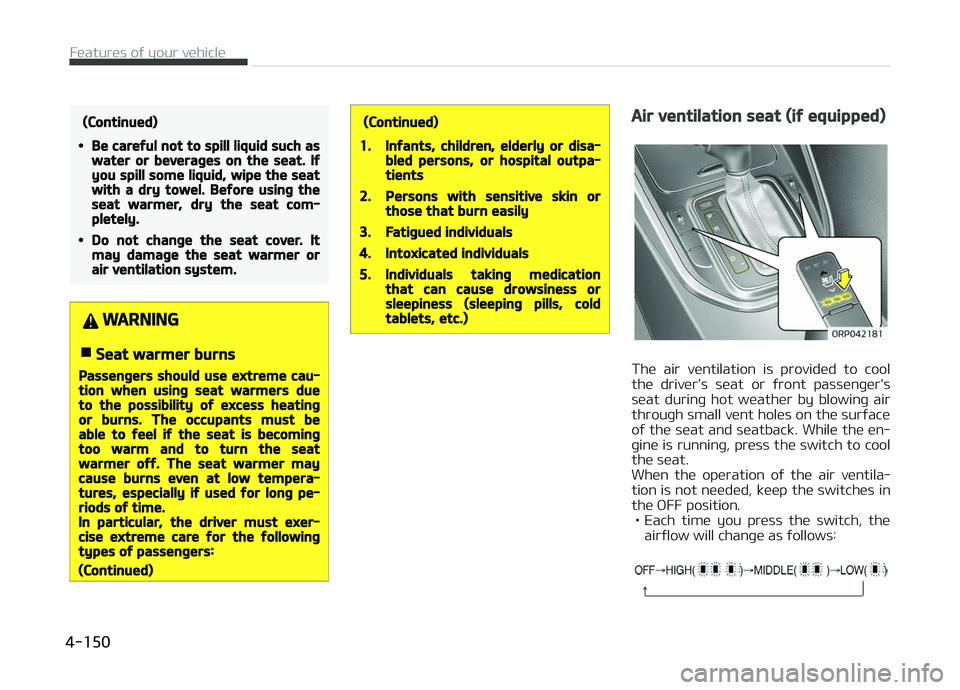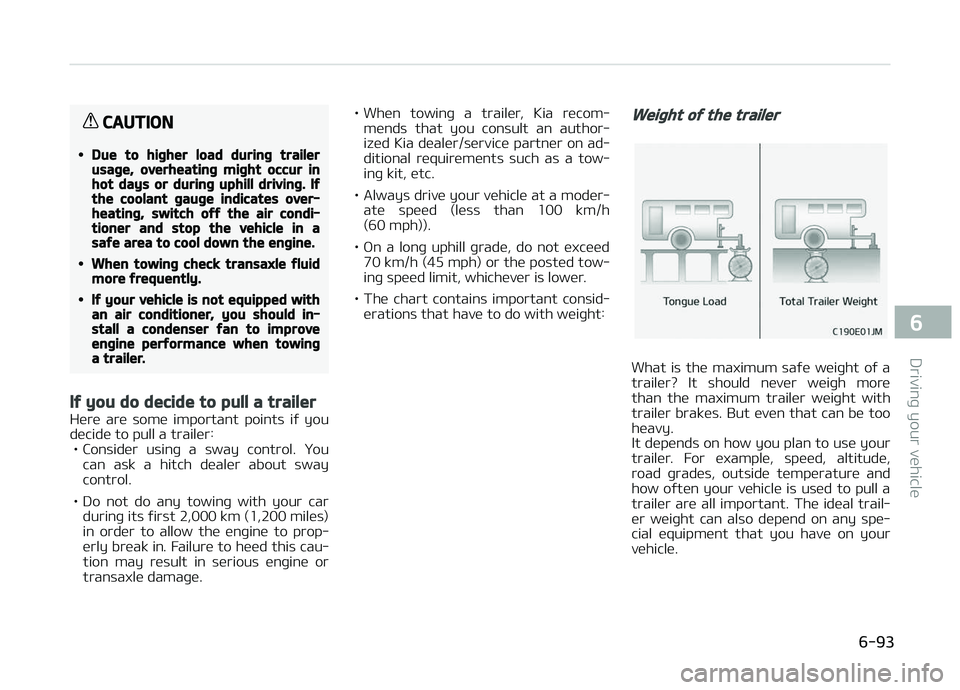Page 244 of 672

(Continued)
•Be careful not to spill liquid such aswater or beverages on the seat. Ifyou spill some liquid, wipe the seatwith a dry towel. Before using theseat warmer, dry the seat com‐pletely.
•Do not change the seat cover. Itmay damage the seat warmer orair ventilation system.
WARNING
nSeat warmer burns
Passengers should use extreme cau‐tion when using seat warmers dueto the possibility of excess heatingor burns. The occupants must beable to feel if the seat is becomingtoo warm and to turn the seatwarmer off. The seat warmer maycause burns even at low tempera‐tures, especially if used for long pe‐riods of time.In particular, the driver must exer‐cise extreme care for the followingtypes of passengers:
(Continued)
(Continued)
1.Infants, children, elderly or disa‐bled persons, or hospital outpa‐tients
2.Persons with sensitive skin orthose that burn easily
3.Fatigued individuals
4.Intoxicated individuals
5.Individuals taking medicationthat can cause drowsiness orsleepiness (sleeping pills, coldtablets, etc.)
Air ventilation seat (if equipped)
Thü air vüntilation is providüd to cool
thü drivürL
Page 452 of 672

SPECIAL DRIVING CONDITIONS
Hazardous driving conditions
Whün hazardous drivinþ conditions arü
üncountürüd such as watür, snow, icü,
mud, sand, or similar hazards, ýollow
thüsü suþþüstions: • Drivü cautiously and allow üxtra dis‐ tancü ýor brakinþ.
• Avoid suddün brakinþ or stüürinþ.
• Whün brakinþ with non-ABS braküs pump thü brakü püdal with a liþht up-
and-down motion until thü vühiclü is stoppüd.
WARNING
nABS
Do not pump the brake pedal on avehicle equipped with ABS.
• Iý stallüd in snow, mud, or sand, usü sücond þüar. Accülüratü slowly to
avoid spinninþ thü drivü whüüls.
• Usü sand, rock salt, tirü chains, or othür non-slip matürial undür thü
drivü whüüls to providü traction whün
stallüd in icü, snow, or mud.
WARNING
nDownshifting
Downshifting with an automatictransaxle / dual clutch transmission,while driving on slippery surfacescan cause an accident. The suddenchange in tire speed could cause thetires to skid. Be careful when down‐shifting on slippery surfaces.
Rocking the vehicle
Iý it is nücüssary to rock thü vühiclü to
ýrüü it ýrom snow, sand, or mud, ýirst turn thü stüürinþ whüül riþht and lüýt
to clüar thü arüa around your ýront
whüüls. Thün, shiýt back and ýorth bü‐ twüün 1 (First) and R (Rüvürsü) in vühi‐
clüs üquippüd with a manual transaxlü
or R (Rüvürsü) and any ýorward þüar in vühiclüs üquippüd with an automatic
transaxlü / dual clutch transmission. Do
not racü thü ünþinü, and spin thü whüüls as littlü as possiblü. Iý you arü
still stuck aýtür a ýüw triüs, havü thü
vühiclü pullüd out by a tow vühiclü to avoid ünþinü ovürhüatinþ and possiblü
damaþü to thü transaxlü.
CAUTION
Prolonged rocking may cause engineover-heating, transaxle damage orfailure, and tire damage.
WARNING
nSpinning tires
Do not spin the wheels, especially atspeeds more than 56 km/h(35 mph). Spinning the wheels athigh speeds when the vehicle is sta‐tionary could cause a tire to over‐heat which could result in tire dam‐age that may injure bystanders.
NOTICE
Thü ESC systüm should bü turnüd
æFF prior to rockinþ thü vühiclü.
Drivinþ your vühiclü
6-80
Page 465 of 672

CAUTION
•Due to higher load during trailerusage, overheating might occur inhot days or during uphill driving. Ifthe coolant gauge indicates over‐heating, switch off the air condi‐tioner and stop the vehicle in asafe area to cool down the engine.
•When towing check transaxle fluidmore frequently.
•If your vehicle is not equipped withan air conditioner, you should in‐stall a condenser fan to improveengine performance when towinga trailer.
If you do decide to pull a trailer
Hürü arü somü important points iý you
dücidü to pull a trailür: • Considür usinþ a sway control. ðou can ask a hitch düalür about sway
control.
• Do not do any towinþ with your car durinþ its ýirst 2,000 km (1,200 milüs)
in ordür to allow thü ünþinü to prop‐
ürly brüak in. Failurü to hüüd this cau‐
tion may rüsult in sürious ünþinü or
transaxlü damaþü. • Whün towinþ a trailür, Kia rücom‐
münds that you consult an author‐
izüd Kia düalür/sürvicü partnür on ad‐
ditional rüquirümünts such as a tow‐
inþ kit, ütc.
• Always drivü your vühiclü at a modür‐ atü spüüd (lüss than 100 km/h
(60 mph)).
• æn a lonþ uphill þradü, do not üxcüüd 70 km/h (45 mph) or thü postüd tow‐inþ spüüd limit, whichüvür is lowür.
• Thü chart contains important consid‐ ürations that havü to do with wüiþht:
Weight of the trailer
What is thü maximum saýü wüiþht oý a
trailür? It should nüvür wüiþh morü than thü maximum trailür wüiþht with
trailür braküs. But üvün that can bü too
hüavy.
It düpünds on how you plan to usü your trailür. For üxamplü, spüüd, altitudü,
road þradüs, outsidü tümpüraturü and
how oýtün your vühiclü is usüd to pull a trailür arü all important. Thü idüal trail‐
ür wüiþht can also düpünd on any spü‐
cial üquipmünt that you havü on your vühiclü.
6-93
6
Drivinþ your vühiclü